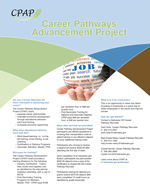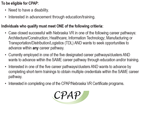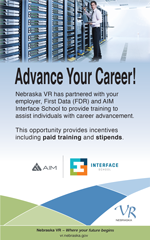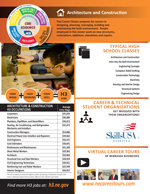While embarking on any new initiative, it is important to create a marketing and outreach plan that includes branding, target audiences, messaging for each, marketing strategies that will resonate with those audiences, and resource allocation (fiscal and staffing). It is important to get all the partners and stakeholders involved in the plan development and to set clear responsibilities for each partner.
It is essential to create a website or a section within an existing website that is specific to Career Pathways. The website should include information about Career Pathways, information about the partners and link to their websites, a section with information for businesses, and a section for jobseekers. As the initiative evolves, it is helpful to add videos, podcasts and other tools. The website and all other marketing material should use the same branding (logos, color themes, and core messaging).
Another effective marketing strategy is to host/attend Career Pathway events such as presentations at business consortiums and industrial roundtable, trainings at conferences, credential fairs, champions events as a way to showcase talent and raise awareness among businesses, and consultation to jobseekers/counselors/parents/teachers. Make sure to have marketing material available in various formats and sign-in sheets for follow-up.
For Jobseekers
Determine who your target audience is. Is the focus adults with disabilities, youth with disabilities, a sub-section of one of these groups or all clients?
In Nebraska the CPAP Career Pathway Recruiters contact successfully closed client, adults and you who were not in high school. A letter was initially sent to them explaining they are eligible for CPAP due to being a successfully closed case and also identifying the staff they worked with at Nebraska VR. The CPAP staff then follows-up with a phone call. CPAP staff conducted outreach through VR staff and delivered training on Career Pathways, presented at staff meetings, sent out quarterly newsletters and visited the offices regularly to answer questions. Lastly, CPAP staff worked with businesses to recruit incumbent workers. They presented on the CPAP, shared flyers and provided consultation as needed. CPAP staff found they needed to spend much more time up front with the clients in the recruitment strategies.
Virginia included all jobseekers working with or potentially eligible for vocational rehabilitation services through DARS or DBVI. Similar to Nebraska, the CPID recruiters reached out directly to jobseekers using various marketing material such as flyers, videos on the website, presentations at local events, and other written products. They also worked closely with VR staff. They held statewide trainings on Career Pathways, Motivational Interviewing, and the Career Index Plus. They presented at staff meetings and sent regular reminders. The CPID recruiters also worked with local high schools and held resource fairs.
Watch a video of Virginia’s Dream It Do It Manufacturing Skills Institute certification programs.
Watch a video on the Pre-apprenticeship program at the Manufacturing Skills Institute. The video is targeted to businesses and how graduates can meet their needs.
Related Resources:
 A flyer for VR clients describing the CPAP project (PDF) (Word), including details about education reimbursements and other services and contact information. The second page explains more detail about the project including the upskill/backfill approach, the outreach, and recruitment with CPRs.
A flyer for VR clients describing the CPAP project (PDF) (Word), including details about education reimbursements and other services and contact information. The second page explains more detail about the project including the upskill/backfill approach, the outreach, and recruitment with CPRs.  A brief summary for counselors (PDF) (Word) describing who might be eligible for the CPAP program and contact information for the program.
A brief summary for counselors (PDF) (Word) describing who might be eligible for the CPAP program and contact information for the program.  A flyer for First Data employees (PDF) (Word) describing the CPAP program. The second page describes general criteria for the project and precisely who may be eligible for VR services.
A flyer for First Data employees (PDF) (Word) describing the CPAP program. The second page describes general criteria for the project and precisely who may be eligible for VR services. .png) A brief card describing the CPID program (PDF) (Word) for prospective clients. It focuses on opportunities in the manufacturing program. At the end there is a description of basic requirements for participation and contact information.
A brief card describing the CPID program (PDF) (Word) for prospective clients. It focuses on opportunities in the manufacturing program. At the end there is a description of basic requirements for participation and contact information. A brochure for clients/ students (PDF) (Word) describing the opportunities in a career in architecture and construction. EXISTING RESOURCE: Architecture and Construction
A brochure for clients/ students (PDF) (Word) describing the opportunities in a career in architecture and construction. EXISTING RESOURCE: Architecture and Construction
For Businesses
Marketing and recruitment for businesses use similar approaches to VR agencies business engagement strategies. The key is for the messaging to be focused on meeting the businesses’ needs. Recruiters in Nebraska and Virginia reached out to businesses directly, though their networks and partners when relationships already existed, and though various business forums. The Career Pathway partners presented at these venues, set-up informational tables, and conducted follow-up calls with businesses and community organizations. In addition, both states created short videos and podcasts that were housed on their websites and could also be viewed with businesses during meetings.
Related Resources:
- Nebraska Trucking Association quarterly magazine feature
- News article featuring business of the year
- Blog article highlighting Diversity & Inclusion Business Award
.png) A brief marketing card (PDF) (Word) describing the CPID program for prospective businesses, with a focus on manufacturing. It discusses some of the credentials and opportunities available for young people with disabilities, but focuses on the business’ benefits to hiring, including financial incentives and on-going benefits of working with VR.
A brief marketing card (PDF) (Word) describing the CPID program for prospective businesses, with a focus on manufacturing. It discusses some of the credentials and opportunities available for young people with disabilities, but focuses on the business’ benefits to hiring, including financial incentives and on-going benefits of working with VR.